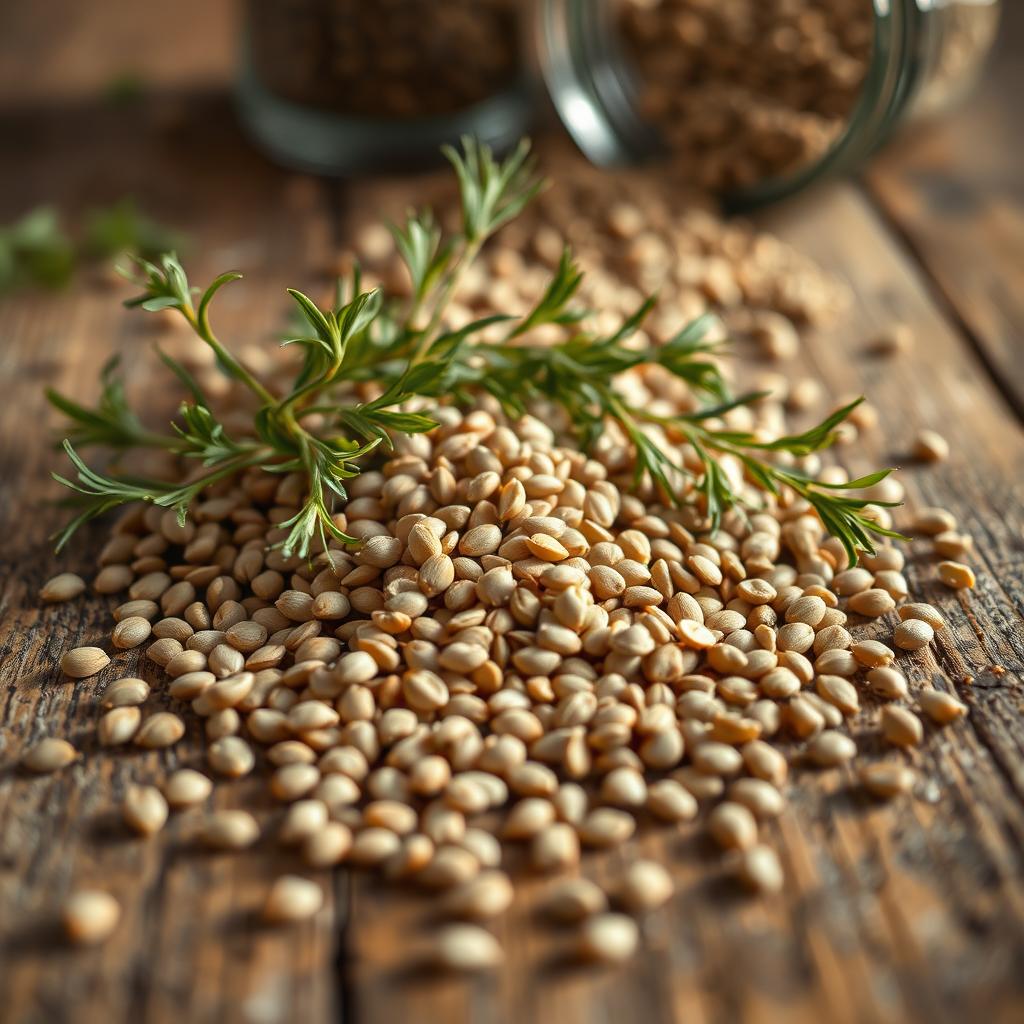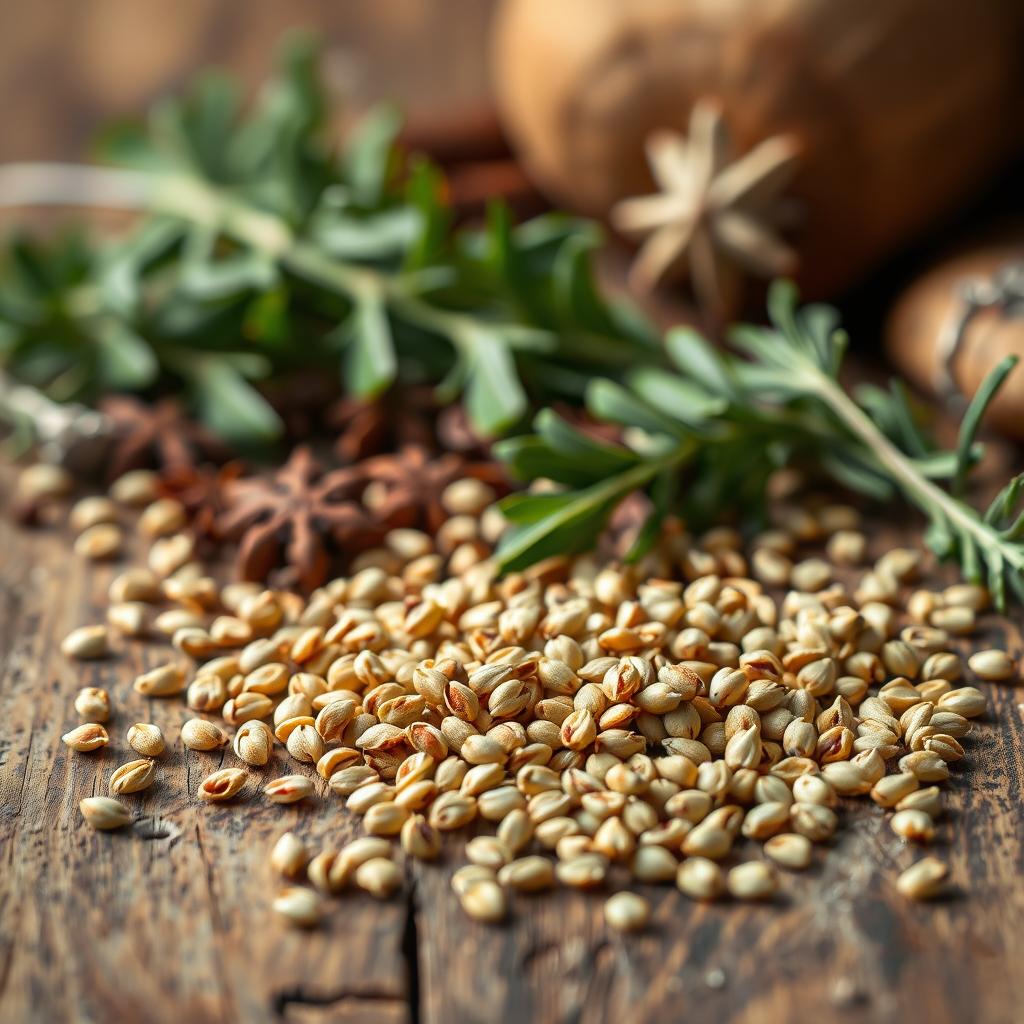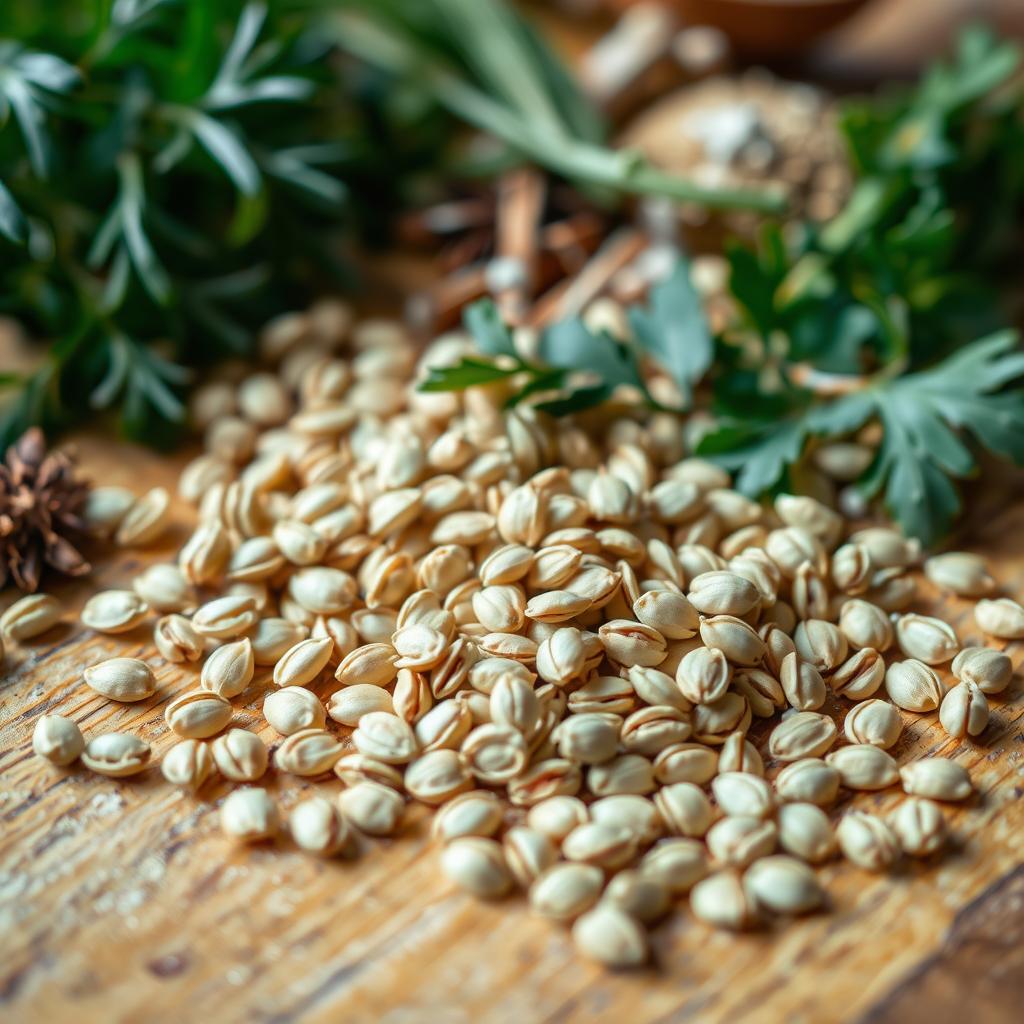Ever been drawn to the unique smell of caraway seeds? Wondered how to use them in cooking? I’ve always loved bold flavors and unique ingredients. Caraway seeds can truly change a simple dish into something amazing.
In this guide, we’ll dive into caraway seeds’ uses. We’ll look at their history, flavor, and how they can improve your cooking. Whether you’re a pro chef or a home cook, you’ll find many ways to use these versatile seeds.

Key Takeaways
- Caraway offer a unique and earthy flavor profile that can elevate a variety of dishes.
- From traditional European recipes to modern cooking techniques, caraway seeds have a wide range of culinary applications.
- Caraway can provide health benefits, such as aiding digestion and offering antioxidant properties.
- Proper storage and preservation methods are crucial to maintaining the freshness and flavor of caraway seeds.
- Incorporating caraway seeds into your cooking can add depth, complexity, and a touch of history to your meals.
Introduction to Caraway Seeds: Ancient Spice for Modern Cooking
Caraway have a long history, coming from the Mediterranean and Middle East. These small, crescent-shaped seeds have been used for centuries. They add a unique caraway seeds flavor to many dishes. Today, they are a key part of cooking, fitting into both old and new recipes.
Origin and Historical Significance
Caraway have been around for thousands of years. They were used in ancient places like Egypt, Greece, and Rome. People valued them for their taste and health benefits, using them in breads and stews.
As time went on, caraway seeds became popular in Europe, especially in German, Austrian, and Scandinavian cooking.
Identifying Caraway
Caraway are easy to spot because of their crescent shape and earthy smell. They are small, about 2-4 millimeters long, and can be light or dark brown. When you crush or toast them, they smell like licorice.
Basic Characteristics and Flavor Profile
Caraway have a special taste that’s different from other spices. They taste a bit sweet, nutty, and peppery, with hints of anise or fennel. This mix of flavors makes them great for many dishes, both savory and sweet.

“Caraway seeds have a unique flavor that can add depth and complexity to both sweet and savory dishes. Their earthy, slightly sweet notes pair beautifully with a variety of ingredients, making them a must-have in the modern cook’s spice cabinet.”
Caraway have been loved for centuries, used in cooking all over the world. From ancient times to today, they inspire cooks of all levels. Check out caraway seeds and see how they can make your cooking better.
The Distinctive Flavor Profile of Caraway Seeds
Caraway are known for their unique flavor. They have an earthy taste with hints of anise, citrus, and pepper. This mix makes them great for many dishes, from savory to sweet.
Caraway are loved in cooking because they enhance other flavors. They balance rich foods with their earthy sweetness. Their peppery taste adds depth to sauces and baked goods. They make stews, sauerkraut, and rye bread even better.
| Flavor Notes | Food Pairings |
|---|---|
| Earthy | Meats, Roasted Vegetables |
| Anise-like | Breads, Pastries, Sauerkraut |
| Citrus | Salads, Dressings, Sauces |
| Peppery | Stews, Braises, Marinades |
The flavor of caraway is a mix of earthy and sweet notes. It can make any dish special. Whether you’re using caraway seeds for their distinctive flavor or trying new recipes, you’ll find endless possibilities.

“Caraway seeds add a warm, slightly sweet, and earthy flavor that complements many savory and baked dishes. Their unique taste can transform a simple meal into something truly special.”
What Do You Use Caraway Seeds For?
Caraway have been a key spice in cooking for centuries. They are used in both traditional European dishes and modern recipes. Find out how to use caraway seeds in your cooking.
Common Culinary Applications
In many European dishes, caraway are a must-have. They add depth to rye breads, sauerkraut, and stews. You can also use them to flavor roasted meats, veggies, and cheese.
Traditional Uses Worldwide
- In Indian cooking, caraway seeds flavor curries, pickles, and chutneys.
- Middle Eastern dishes often include caraway seeds in breads, rice, and meat.
- In North Africa, caraway seeds are in spice blends and tagines.
Modern Cooking Techniques
Caraway are also great for modern cooking. You can roast, toast, or grind them to bring out their flavor. They’re also good for infusing oils and vinegars with their aroma.
Caraway bring a unique taste to any dish. They can make your cooking stand out. Discover the many ways you can use caraway seeds to improve your recipes.
Essential Tips for Cooking with Caraway Seeds
Caraway seeds add a unique flavor to many dishes. They can make savory recipes and baked goods even better. Here are some key tips to use caraway seeds effectively.
Toasting Caraway Seeds
Toasting caraway seeds brings out their best taste and smell. Heat them in a dry skillet over medium heat, stirring often, until fragrant and slightly dark. This step releases their oils and intensifies their flavor.
Grinding for Deeper Flavor
Grinding caraway into powder can make their flavor more intense. Use a spice grinder, coffee grinder, or mortar and pestle. This way, the caraway flavor spreads evenly through your dish.
Incorporating Whole Seeds
Whole caraway add a nice crunch and look to your dishes. Sprinkle them over baked goods, soups, stews, or salads. It boosts the texture and taste.
| Tip | Benefit |
|---|---|
| Toast caraway before use | Enhances flavor and aroma |
| Grind caraway into a powder | Provides a stronger, more consistent flavor |
| Use whole toasted seeds | Adds a delightful crunch and visual appeal |
Mastering these techniques will help you use caraway seeds to their fullest in caraway seeds cooking and caraway seeds recipes. Your dishes will taste and look amazing.
Traditional European Recipes Featuring Caraway Seeds
Caraway have a long history in European cooking. They add a unique flavor to many classic dishes. From German and Austrian rye breads to Eastern European goulash, these seeds are key to authentic tastes.
German and Austrian Dishes
In Germany and Austria, caraway seeds are a must in rye breads. They give a warm, nutty smell and a nice crunch. These breads are perfect for Brotzeit, topped with smoked meats, sharp cheeses, and tangy sauces.
Caraway also spice up Austrian goulash. This slow-cooked beef stew is flavored with paprika and other spices.
Eastern European Specialties
- Polish sauerkraut (fermented cabbage) is loved for its tangy taste, thanks to caraway seeds.
- In Russia, caraway seeds are crucial in kvass, a fermented rye bread drink.
- Caraway seeds are also found in pierogi (stuffed dumplings) and borscht (beet soup) in Eastern Europe.
Scandinavian Cuisine
In Scandinavia, caraway are essential. In Sweden, they’re a key ingredient in aquavit, a strong spirit. They’re also in rye breads, crackers, and cheese recipes across the Nordic region.
“Caraway are the unsung heroes of many beloved European dishes, adding depth, complexity, and an unmistakable flavor that transports you to the heart of the continent.”
Baking with Caraway Seeds: From Bread to Pastries
Caraway are more than just for rye bread. They can make many baked goods taste better, from savory crackers to sweet pastries.
Caraway are a key part of traditional rye bread. Their licorice-like taste goes well with rye flour’s earthy and nutty flavors. This makes the bread taste unique. But caraway seeds can also improve whole wheat and sourdough breads. They add depth and complexity.
Caraway are great in crackers, biscuits, and savory pastries too. They add a crunchy texture and strong flavor. Adding them to simple crackers or tart fillings can make them special.
In sweet baked goods, caraway work well too. They complement the richness of cakes and the flakiness of danish pastries. A sprinkle on a coffee cake or in Danish dough can surprise and please your taste buds.
When baking with caraway , use them wisely. Too much can overpower the taste. Start with a small amount and adjust to your liking. With some trial and error, you’ll find the best way to use this spice in your baking.
Caraway Seeds in Vegetable Dishes and Salads
Caraway are great for more than just bread and baked goods. They can also make vegetable dishes and salads taste better. From sauerkraut to fresh salads, they add depth and complexity to plant-based recipes.
Sauerkraut and Fermented Foods
Caraway are a key ingredient in sauerkraut, a fermented cabbage dish from Germany. Their nutty, earthy flavor complements sauerkraut’s tangy taste. Adding caraway seeds to the fermentation process gives cabbage a unique aroma and taste.
Caraway are also good in other fermented foods like pickled beets and kimchi. They make these foods more complex and interesting. This makes them a great addition to your cooking.
Fresh Vegetable Preparations
- Roasted Carrots and Parsnips: Mix caraway seeds with olive oil, salt, and pepper. Roast with carrots and parsnips for a tasty side dish.
- Cabbage and Kale Salad: Sprinkle caraway seeds on a cabbage and kale salad. Dress with a tangy vinaigrette for a healthy, flavorful meal.
- Grilled Zucchini: Rub caraway seeds, garlic, lemon, and herbs on zucchini slices before grilling. It makes a smoky, aromatic dish.
Caraway are versatile in fresh vegetable dishes. They add a unique flavor to roasted roots and vibrant salads. This makes plant-based cooking more exciting.
Health Benefits and Medicinal Uses
Caraway add flavor to many dishes and offer health benefits. These small seeds have been used in traditional medicine for centuries. Recent studies have shown their potential health benefits.
Caraway are good for your digestive health. They have carminative properties, which help reduce gas and bloating. They contain compounds like carvone and limonene, which may fight inflammation and support a healthy gut.
- Caraway help with indigestion, heartburn, and other digestive problems.
- They might also help flush out toxins and support kidney health.
- Research suggests they could help with inflammation, useful for arthritis.
Caraway also have antimicrobial effects. Studies show they can fight off bacteria like E. coli and Staphylococcus. This could help boost your immune system.
“Caraway seeds have been used in traditional medicine for a variety of ailments, and modern research is beginning to uncover their potential health benefits.”
To enjoy caraway benefits, add them to savory dishes, baked goods, or drinks. They add a unique flavor to many recipes, making them a healthy choice.
Storing and Preserving Caraway
Keeping caraway fresh is key to their flavor and smell. Store them in an airtight container, like a glass jar or plastic bag. Place it in a cool, dark spot, like your pantry or spice cabinet. Heat, light, and moisture can make them lose their taste and smell.
Proper Storage Methods
Caraway need a cool, dry place to stay fresh. Don’t store them in the fridge or freezer. The changing temperatures can make them lose flavor. Instead, choose a dark, cool spot in your kitchen.
Shelf Life Guidelines
Caraway can last 2 to 3 years if stored right. But, watch for signs of spoilage like a musty smell or color change. If you see any, it’s time to get new caraway seeds spice. Following these tips will keep your seeds flavorful and aromatic for your cooking.

